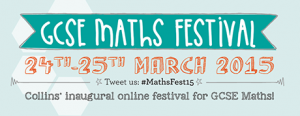Mini-investigations
I was asked a few days ago about the suggestion in my blogs for the Collins Online Maths Festival that we should be introducing mini-investigations. I see these as a way of bringing together a number of syllabus strands so that students can start to make connections between the various topics that they have been studying. This is not just a means to get some revision into the scheme of work but an attempt to encourage and develop the skills connected to the logical presentation of solutions and the independent development of ideas. This idea is relevant to both the Foundation and Higher Tiers.
I believe the key issue comes with the adjustment of the Assessment Objectives – especially AO2 – where students are expected to reason, interpret and communicate mathematically. Can my students make deductions, inferences and draw conclusions; can they construct chains of reasoning; can they assess the validity of an argument?
The new maths GCSE syllabus is so expansive that instead of being linear, it effectively becomes spiral, as topics need to be revisited and new depth added. Why not, at regular intervals of once every half-term, devote 4 or 5 lessons (3 to 4 hours) aimed at pulling together a number of previously taught topics in open-ended, investigative work?
One suggestion I offered was sports related. I have a Y11 class at the moment who are all boys, with nearly all of them involved in one sports team or another and some of them doing GCSE PE. What strands and topics is it possible to combine here?
Focus on the layout of a soccer pitch, basketball court or a track and field arena, and look at area, perimeter, trigonometry, scale drawing, construction, percentages, ratio.
As a starter this would throw together:
- Area and perimeter of pitches/playing field (G14)
- Shape of elements of the playing field (G4)
- Area of elements in the playing field (centre circle, goalkeeper area, javelin/discus throwing area, … (G9, G18)
- Percentage of elements to whole area (R3, R9)
- Comparison of different dimensions of pitches, for example, as stated by the sport’s governing body (N16)
- Scale drawings of the playing surface with markings (R2, G2)
- Metric/ Imperial conversion of dimensions (N13)
- Total revenue from spectator attendance (N2), over the season/per game (S4)
- Ratio breakdown of spectators; male:female, adult:child, away:home, … (R5)
- Average attendance figures (S4, N14)
- Mean/median/mode goals/points per game/player (S4)
- Player on pitch shooting for goal/basket, angle of ball trajectory/ distance from target (G20)
- Relative sizes of volume/surface area of balls used (G17, R5, R9)
- Area of front area of the goal, area of netting required for goal/discus throwing circle (R12, G12)
- Spectator view to pitch (angle of depression)/distance, player view to stands (angle of elevation)/distance, … (G20)
This list can be extended and matched by your/ the students’ imagination. What about the cost of re-turfing the pitch: cost of turf (£/m2), labour cost, VAT payments, manpower needed, volume of water used by the sprinklers at half time, rate of flow of the water, cost, …
Students could be tasked in small groups to research data for many of the bullet points above. Sport is a fantastic generator of statistical information.
Line graphs, bar charts, pie charts and the like are all possible from the list given above: ratio of spectators, number of defenders:midfield:attackers, attendance patterns across the season, revenue per game across the season, …
I am convinced that getting students talking, engaging, collaborating, discussing and exploring is really good for vocabulary and method, and stimulates a better understanding and connection of a variety of strands. Done well, this will encourage and develop student reasoning, their ability to make inferences and deductions, and check out the validity of an argument.
Above all this kind of approach will develop confidence – a vital attribute that all our students need.
@cpstobart
 Collins are hosting its inaugural online GCSE Maths Festival next week – 24th-25th March. Do take a look at what will be happening, sign up, and join in! I’ve written the blog that appears on Monday – Delivering the Foundation Tier of the new GCSE.
Collins are hosting its inaugural online GCSE Maths Festival next week – 24th-25th March. Do take a look at what will be happening, sign up, and join in! I’ve written the blog that appears on Monday – Delivering the Foundation Tier of the new GCSE.